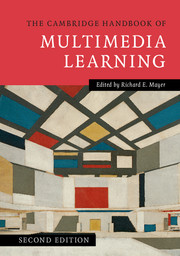Book contents
- The Cambridge Handbook of Multimedia Learning
- The Cambridge Handbook of Multimedia Learning
- Copyright page
- Contents
- Contributors
- Preface
- Acknowledgments
- 1 Introduction to Multimedia Learning
- Part I Theoretical Foundations
- Part II Basic Principles of Multimedia Learning
- Part III Advanced Principles of Multimedia Learning
- 15 The Guided Discovery Learning Principle in Multimedia Learning
- 16 The Worked Examples Principle in Multimedia Learning
- 17 The Self-Explanation Principle in Multimedia Learning
- 18 The Generative Drawing Principle in Multimedia Learning
- 19 The Feedback Principle in Multimedia Learning
- 20 The Multiple Representation Principle in Multimedia Learning
- 21 The Learner Control Principle in Multimedia Learning
- 22 Animation Principles in Multimedia Learning
- 23 The Collaboration Principle in Multimedia Learning
- 24 The Expertise Reversal Principle in Multimedia Learning
- 25 The Individual Differences in Working Memory Capacity Principle in Multimedia Learning
- Part IV Multimedia Learning of Cognitive Processes
- Part V Multimedia Learning in Advanced Computer-Based Contexts
- Author Index
- Subject Index
23 - The Collaboration Principle in Multimedia Learning
from Part III - Advanced Principles of Multimedia Learning
Published online by Cambridge University Press: 05 August 2014
- The Cambridge Handbook of Multimedia Learning
- The Cambridge Handbook of Multimedia Learning
- Copyright page
- Contents
- Contributors
- Preface
- Acknowledgments
- 1 Introduction to Multimedia Learning
- Part I Theoretical Foundations
- Part II Basic Principles of Multimedia Learning
- Part III Advanced Principles of Multimedia Learning
- 15 The Guided Discovery Learning Principle in Multimedia Learning
- 16 The Worked Examples Principle in Multimedia Learning
- 17 The Self-Explanation Principle in Multimedia Learning
- 18 The Generative Drawing Principle in Multimedia Learning
- 19 The Feedback Principle in Multimedia Learning
- 20 The Multiple Representation Principle in Multimedia Learning
- 21 The Learner Control Principle in Multimedia Learning
- 22 Animation Principles in Multimedia Learning
- 23 The Collaboration Principle in Multimedia Learning
- 24 The Expertise Reversal Principle in Multimedia Learning
- 25 The Individual Differences in Working Memory Capacity Principle in Multimedia Learning
- Part IV Multimedia Learning of Cognitive Processes
- Part V Multimedia Learning in Advanced Computer-Based Contexts
- Author Index
- Subject Index
Summary
Taking a cognitive perspective on collaborative learning in a multimedia learning environment has led to the identification and understanding of conditions under which collaborative learning is most effective and efficient, as articulated by the collaboration principle in multimedia learning. Simply stated, learning in teams – that is, collaborative learning – is most effective when the learning task is cognitively demanding enough to warrant collaboration (i.e., complex enough to overly tax the working memory of an individual learner) and when the benefits of collaboration exceed the transactional activity costs. From a cognitive perspective, groups are considered information processing systems in which – through communication of information and coordination of actions – group members can make use of each other’s processing capacity, resulting in a collective working space (i.e., the collective working memory effect). Although this distribution of information processing is an advantage when problems are cognitively demanding and hard for the individual to solve (i.e., distribution advantage), it can be a disadvantage when problems are cognitively undemanding, because group members have to cognitively invest in associated transactional activities (i.e., transactional activity costs). The trade-off between the distribution advantage and transactional activity costs can be an indicator of the efficiency of group learning in multimedia learning environments. The communication and coordination tools provided by multimedia learning environments can be used to influence and optimize this trade-off. Implications for instructional design and future research are addressed.
Keywords
- Type
- Chapter
- Information
- The Cambridge Handbook of Multimedia Learning , pp. 547 - 575Publisher: Cambridge University PressPrint publication year: 2014
- 10
- Cited by



